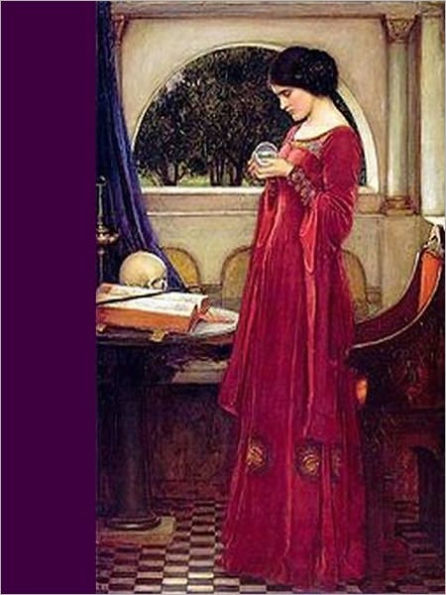"Lilith is a character in Jewish mythology, found earliest in the Babylonian Talmud (completed between 500 and 700 AD/CE), who is generally thought to be related to a class of female demons Lili?u in Mesopotamian texts. However, Lowell K. Handy (1997) notes, "Very little information has been found relating to the Akkadian and Babylonian view of these demons. Two sources of information previously used to define Lilith are both suspect."[1] The two problematic sources are the Gilgamesh appendix and the Arslan Tash amulets, which are discussed below.[2]
In Jewish folklore, from the 8th–10th Century Alphabet of Ben Sira onwards Lilith becomes Adam's first wife, who was created at the same time and from the same earth as Adam. This contrasts with Eve, who was created from one of Adam's ribs. The legend was greatly developed during the Middle Ages, in the tradition of Aggadic midrashim, the Zohar and Jewish mysticism.[3] In the 13th Century writings of Rabbi Isaac ben Jacob Alfasi ha-Cohen, for example, Lilith left Adam after she refused to become subservient to him and then would not return to the Garden of Eden after she mated with archangel Samael.[4] The resulting Lilith legend is still commonly used as source material in modern Western culture, literature, occultism, fantasy, and horror." -- Wikipeda
1103586310
In Jewish folklore, from the 8th–10th Century Alphabet of Ben Sira onwards Lilith becomes Adam's first wife, who was created at the same time and from the same earth as Adam. This contrasts with Eve, who was created from one of Adam's ribs. The legend was greatly developed during the Middle Ages, in the tradition of Aggadic midrashim, the Zohar and Jewish mysticism.[3] In the 13th Century writings of Rabbi Isaac ben Jacob Alfasi ha-Cohen, for example, Lilith left Adam after she refused to become subservient to him and then would not return to the Garden of Eden after she mated with archangel Samael.[4] The resulting Lilith legend is still commonly used as source material in modern Western culture, literature, occultism, fantasy, and horror." -- Wikipeda
Lilith - The Legend of the First Woman
"Lilith is a character in Jewish mythology, found earliest in the Babylonian Talmud (completed between 500 and 700 AD/CE), who is generally thought to be related to a class of female demons Lili?u in Mesopotamian texts. However, Lowell K. Handy (1997) notes, "Very little information has been found relating to the Akkadian and Babylonian view of these demons. Two sources of information previously used to define Lilith are both suspect."[1] The two problematic sources are the Gilgamesh appendix and the Arslan Tash amulets, which are discussed below.[2]
In Jewish folklore, from the 8th–10th Century Alphabet of Ben Sira onwards Lilith becomes Adam's first wife, who was created at the same time and from the same earth as Adam. This contrasts with Eve, who was created from one of Adam's ribs. The legend was greatly developed during the Middle Ages, in the tradition of Aggadic midrashim, the Zohar and Jewish mysticism.[3] In the 13th Century writings of Rabbi Isaac ben Jacob Alfasi ha-Cohen, for example, Lilith left Adam after she refused to become subservient to him and then would not return to the Garden of Eden after she mated with archangel Samael.[4] The resulting Lilith legend is still commonly used as source material in modern Western culture, literature, occultism, fantasy, and horror." -- Wikipeda
In Jewish folklore, from the 8th–10th Century Alphabet of Ben Sira onwards Lilith becomes Adam's first wife, who was created at the same time and from the same earth as Adam. This contrasts with Eve, who was created from one of Adam's ribs. The legend was greatly developed during the Middle Ages, in the tradition of Aggadic midrashim, the Zohar and Jewish mysticism.[3] In the 13th Century writings of Rabbi Isaac ben Jacob Alfasi ha-Cohen, for example, Lilith left Adam after she refused to become subservient to him and then would not return to the Garden of Eden after she mated with archangel Samael.[4] The resulting Lilith legend is still commonly used as source material in modern Western culture, literature, occultism, fantasy, and horror." -- Wikipeda
3.69
In Stock
5
1

Lilith - The Legend of the First Woman

Lilith - The Legend of the First Woman
Related collections and offers
3.69
In Stock

Product Details
| BN ID: | 2940012792891 |
|---|---|
| Publisher: | Inspiratrix |
| Publication date: | 07/19/2011 |
| Sold by: | Barnes & Noble |
| Format: | eBook |
| File size: | 125 KB |
From the B&N Reads Blog
